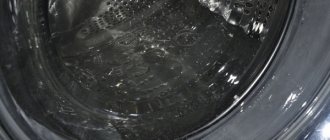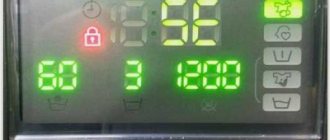Problems with the washing machine are upsetting and often disrupt plans.
Failures can occur at any stage of work, and even such reliable equipment as Samsung is not immune to them. One possible problem is a locked door that cannot be opened.
Why the door of a Samsung washing machine does not open after washing and what to do in this case, we will tell you in the article.
Dismantling instructions
You can try to repair the door by weight, but it is better not to complicate the task for yourself. It is much easier and more convenient to first remove the hatch from the end along with the hinges and slowly check the structure for damage and malfunctions. This is done quickly.
- Loosen the outer clamp on the rubber cuff of the hatch.
There is no need to remove the cuff from the hatch: pulling the elastic band back is difficult and time-consuming!
- Carefully tuck the rubber band into the drum.
- Unscrew the bolts holding the hinges using a Phillips screwdriver.
That's not all. In addition to the bolts, the door is also held in place by special plastic clips in the form of hooks. Therefore, it is necessary to raise the hatch by 4-5 mm, and then pull it away from the machine. There should be no difficulties - the door will “leave” the grooves and remain in the hands of the master.
Why remove this element?
There is no need to start repairs right away. Before unscrewing the door, you need to study its design and the electrical circuit of the washing machine. As a rule, most Samsung washing machines have a standard device, but it is better to play it safe and first study the technical documentation.
You should also try to determine the cause and nature of the malfunction before disassembling. Practice shows that the door most often breaks due to the following breakdowns:
- glass burst;
- the lock jams or does not work (the door does not close or open);
- hinges sag;
- the support on the hinge broke.
If there are no visual problems with the glass, hinges and locking mechanism, then the UBL has probably failed. The hatch locking device is an electronic lock that additionally protects the door from accidental opening during the washing process. You can more accurately determine the cause of the malfunction using typical symptoms.
Cautions
When the washing machine door is locked, you may want to open it as quickly as possible. At this stage, serious damage to equipment is possible.
To avoid them, you should remember a number of prohibitions:
- If the hatch is locked, then you cannot pull or pull the handle with force. There is a risk of damage to the hatch.
- Do not try to force the door open using a crowbar, large screwdriver, or other rough tool. Such unjustified actions can lead to breakage of the hatch, damage to the cuff and deformation of the machine itself.
- If there is any doubt about the serviceability of the door mechanism, it should be addressed. The problem should not be left “for later”.
- Do not try to open the door before the water has drained from the machine.
The fixing elements are broken
More often than not, problems with the locking mechanism prevent the door from closing tightly. More precisely, the latch lever becomes deformed during careless or too long use, which leads to the appearance of unevenness and bevels. All this prevents the door from locking into the provided grooves. The problem is fixed as follows:
- the door is removable;
- the hatch is placed on a flat surface with the latch facing up;
- use a file to grind off all the irregularities on the latch;
- the latch is treated with graphite lubricant (for preventive purposes);
- the door is installed on the body.
Do not hang wet things on the hatch door and allow children to “ride” on them!
Often the door does not close tightly due to sagging hinges or loose external fasteners. In this case, it is necessary to adjust the position of the hinges. But you will have to act by eye - tighten the fasteners until the latch fits into the groove.
External reasons
External faults are easier to detect than internal faults. In a normally operating device, when the door is completely closed, a click can be clearly heard. If the hatch does not close completely, the lock does not lock, it is obvious that some part is broken, bent or skewed. Usually such a breakdown can be seen visually.
Broken hatch door handle
The door handle is made of plastic. After several years of use or as a result of careless handling, the fragile material may break. To avoid this, do not slam the door too hard, hang wet things on it, allow children to play with the hatch, or try to open the machine before the locking time ends. If the handle does break, you can replace it with a new part.
The work of replacing the handle is carried out in several stages.
- Disconnect the device from the mains, remove the door from its hinges and disconnect it from the machine.
- The hatch is disassembled into two parts; to do this, unscrew the connecting screws. Using a blunt knife, separate the plastic rings and pull out the glass.
- In the door device, the handle is fixed using a long metal pin, which must be carefully pulled out. After this, the mechanism will fall into four parts: a broken plastic plate, a pin, a return spring and a hook.
They replace the old part with a new one and reassemble the door in the reverse order, checking the position of the parts using photographs.
Skewed locking tongue or hinges on the door
If you press hard on the car door, you can bend or even break the retaining hinge. In addition, the cause of such a nuisance may be the initial incorrect installation of the device, when the machine shakes and vibrates during operation, as well as low-quality components made from fragile materials.
In this case, you need to visually assess the amount of misalignment and, if possible, adjust the position of the hinge by tightening the loose screws. If it is clear that the damage is serious, the bearings and door trim are damaged, you will have to replace the hinge with a new one.
The work is carried out as follows.
- Remove the door from the machine.
- Unscrew the connecting screws and disassemble the door.
- The decorative flanges are disconnected and the glass is removed. If the plastic parts of the hatch are damaged, they can be replaced.
- Most often, the hinge bearings and the metal hinge break. These parts must be removed from the device and replaced.
- Assembly is carried out in reverse order.
Glass damaged
If the glass on the door is cracked, then there will be no problems with diagnostics - you can immediately begin repairs. After removing the hatch from the body, we get to work. It is important to understand that operating a “broken” machine is highly discouraged: if the seal is broken, there is a high probability of leakage and electric shock.
Replacing glass is also not an option, since this option is available for single models. Therefore, the user has only two options: buy a new machine or seal the gap. The second method is cheaper, but will require some steps.
The crack is sealed according to the following instructions.
- Secure the film on the outside of the glass with tape, avoiding voids and cracks.
- Apply reinforcing tape to the inside.
- Mix resin and hardener in a ratio of 6 to 4, adding EDP glue. You should get a homogeneous mass, similar to liquid sour cream. If the composition is too thick, it is recommended to heat it in a water bath, stirring regularly.
To seal cracks in sunroof glass, it is better to use epoxy resin, as tape and sealant give short-term results.
- Fill the crack with the prepared mixture.
- Leave for a day.
- Remove the polyethylene and sand the glass.
It is not recommended to use tape and sealant instead of epoxy resin solution - they do not last as well and give short-term results. But you need to strictly observe the proportions. Otherwise, the “protection” will not last long.
Repairing damage
Immediately prepare the necessary tools and materials:
- Phillips and slotted screwdriver.
- spare parts for replacement (lock, tongue, spare glass).
UBL repair
Can't open the hatch after washing? The UBL lock may have broken. Since it runs on electronics, check to see if the lights in the apartment have been turned off. In this case, the door will remain locked.
The operating principle of the UBL is simple: the control module supplies electric current to the lock plates. When heated, they bend and press on the latch, which latches the hatch.
How to understand that the device is broken? According to these signs:
- After turning off the machine, the hatch does not open.
- When you start the wash, an error code appears on the screen.
- You've loaded laundry, but the lock won't lock.
To make sure that the problem is in the device and not the control board, you need to carry out diagnostics with a multimeter.
- Attach the tester probes to the “neutral” and “lock phase” contacts.
- Measure the indicators.
- Everything works if three numbers are shown on the screen.
- Then attach the probes to the “neutral” and “common” contacts.
- Zeros or one on the screen indicate a breakdown.
To open the door when locked, you can use the method suggested by our users. Take a thin ribbon and thread it between the SMA body and the hatch. Holding the ends on both sides, pull the tape towards you. After opening, you can begin repairs.
How to fix it yourself:
- Pull back the cuff.
- Using a screwdriver, remove the clamp. If it is plastic, remove the latch.
- Remove the bolts that hold the device in place.
- Tuck the cuff in and remove the lock.
- Disconnect the wiring.
- Install the new part in reverse order.
Replacing the latch
Over time, the latch lever becomes deformed and irregularities appear on it, which interfere with normal closure. To perform the replacement, you need to know how to remove the door:
- Remove the clamp and rubber cuff. If you don’t want to remove it completely, bend it back and tuck it inside.
- On the side you will see the door mounts.
- Remove two screws.
- Lift the hatch up and remove it from its seat.
To return the latch to a smooth surface, you will need a file - grind off the nicks and irregularities. Lubricate parts with graphite lubricant for better performance. Lock the door in its original place.
The reason for the drum not closing tightly may be sagging hinges or loose fastenings. When installing the hatch in place, you need to adjust its position so that the latch fits normally into the hole.
Glass replacement
It’s good if the glass in your SMA model can be replaced, but such luck is rare. Otherwise, you will have to seal the cracks.
- On the outside you need to attach plastic film with tape. It is important that there are no gaps.
- Apply reinforcing tape to the damaged part.
- In a separate container, prepare a solution of epoxy resin.
- Fill the gap with solution.
- After 24 hours, remove the film. Remove drips with sandpaper.
How to prepare resin? To ensure that the product has good adhesiveness and resistance to temperature changes, a hardener is added to the composition. You can prepare a solution based on EDP glue:
- Take 6 parts resin and 4 parts hardener.
- Mix in a separate container until smooth.
- If it turns out too thick, heat it a little in a water bath.
Read the instructions carefully before diluting: an error in the ratios will affect the quality of the resin.
In some cases, a special sealant can be used, although it will not last as long.
Adjusting or replacing the plastic support
To do this, you need to remove the door, disassemble the handle and repair the support.
- Remove the hatch. Place it on a flat surface.
- Unscrew the fasteners around the perimeter.
- Remove the top and glass.
- Now you can remove and replace the handle if it breaks.
- Remove the repair support and drill a hole with a diameter of 3.8 mm in it.
- File the nail to the desired length. Heat it up and thread it through the hole.
- Wait for it to cool down for 2-3 minutes.
To avoid breaking the handle or other elements, do not pull it hard when opening it. Also close the hatch carefully, do not slam the door. Otherwise, the elements will quickly wear out and break.
Now you know how to make repairs yourself. Follow the operating instructions and read the instructions before turning on. Then the equipment will last for many years.
Opening mechanism
When the door handle is damaged, the sequence of actions will be completely different. After removing the hatch, you will have to tighten all the bolts around the perimeter with a screwdriver, halve the door and remove the glass. Next we proceed to repairing the support:
- drill a hole 3.5-4 mm;
- file the nail down to the depth of the hole;
- heat the nail with a burner for 1-3 minutes;
- insert into the hole;
- We wait for it to harden and check the integrity of the loop.
It is much easier not to repair the door rather than to have problems closing it. You just need to follow the operating rules, carefully close the hatch, do not pull the handle or hang on the door. Otherwise, you will have to constantly deal with wear of parts, sagging hinges and other troublesome breakdowns.
Interesting:
- How to remove the washing machine door?
- Rating of Samsung washing machines
- How to repair a Samsung washing machine
- The red lock on the Samsung washing machine is on
- Ed error on Samsung washing machine
- Reviews of Samsung washing machines
Reader comments
- Share your opinion - leave a comment
Can I solve the problem myself?
If we are talking about minor breakdowns of a technical nature, and you are confident in your qualifications, then why not - fix it yourself, but if the breakdown is inside the unit itself, and you do not have the appropriate skills and equipment, then it is best to entrust the repair to a specialist. If you decide to repair your washing machine yourself, then perhaps these videos will come to your aid:
If you are a fan of professional repairs, then welcome to - here they will listen to you, give advice, accurately determine the breakdown and qualitatively repair your washing machine. Call any day - we are always in touch with you, even on weekends and holidays.
The washing process in a washing machine can only be started if the door of the machine is locked until the end of the operating cycle - this is due to the requirements for the safe operation of the device - to create a perfect seal so that water does not leak out of the tank. Sometimes the machine may simply stop blocking, and until the problem is fixed, it will be impossible to start washing.
First of all, you need to check if anything is caught in the loading hatch door. If there are no obstacles to closing the door, there may be several reasons for this malfunction . Conventionally, they can be divided into two types - mechanical damage and problems with electronics. If you need your washing machine repaired, contact our company.
If the damage is mechanical, then the door will not lock at all and a characteristic click will not be heard. If there are problems with the electronics, then the door may close, but the locking will not occur - a repeated click will not be heard, indicating that the hatch is locked electronically. In the latter situation, the machine should display the corresponding error number on the display.











